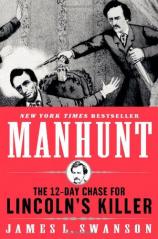Manhunt: The 12-Day Chase for Lincoln's Killer
Review
Manhunt: The 12-Day Chase for Lincoln's Killer
April 14, 1865 is a date of infamy in United States history. It is the day that John Wilkes Booth assassinated Abraham Lincoln. A dedicated Lincoln scholar, attorney James L. Swanson writes the story of Booth's incredible escape from authorities, presenting little-known facts researched with intimate detail. This nonfiction book explores actual pieces written at the time of the assassination and in years beyond by players who took part in the real-life drama, Booth included.
Swanson enters the minds of Booth and his co-conspirators, analyzing their motives, emotions and sympathies. Booth, the consummate actor, remains true to his theatrical accomplishments throughout the drama. Always the thespian, he utilizes his dramatic abilities to wield his way toward freedom in the deep South in each of his encounters. Fleeing with him is Davey Herold, who has been a willing participant in Booth's plots to kill Secretary of State William Seward, Lincoln, and Vice President Andrew Johnson. Conspirators William Powell and George Atzerodt did not fulfill their roles in the multiple assignments in time to flee Washington.
Ford's Theatre, the site of Booth's treachery and Lincoln's subsequent death, becomes both hated and later revered as a place of historical significance. Edwin Stanton, Secretary of War, takes charge of the manhunt for Booth and Herold with immediate dispatch. He utilizes every federal force at his disposal, offering magnanimous rewards for their capture. Private detectives and ordinary citizens are compelled for their help.
Maryland has remained true to the Union, but Virginia, across the wide Potomac River, was a raw arena of Confederate support. There, Booth would attempt the journey to safety among the denizens still friendly to the Southern cause. The fall of Richmond had motivated Booth to organize a kidnapping of the President. When the attempt foiled, Booth made plans for the bold assassinations he believed were necessary.
Swanson writes about all the characters involved in the chase, from actual plot participants to ordinary southern people who aided the murderer and his companion. Two players have special recognition for delaying Booth's capture. A Dr. Mudd gives medical treatment to the handsome man with a broken leg but denies his part when authorities call. From Mudd's home, Booth travels to a swampy wooded ravine where fate extends his days on the run; it comes in the person of Thomas A. Jones, former Secret Service veteran and Confederate spy. While Stanton's hunters follow leads and ride roadways beside the thickets, Booth and Herold remain sequestered for days until Jones can offer them a safe river crossing.
MANHUNT is a fascinating story from American history. The reader reaches an understanding of the raw political arena in Washington directly after the Civil War. Booth is not presented as a sympathetic figure; his motivations, however misdirected, draw a picture of a man enveloped and chained to his beliefs. His charisma as an actor put him in the spotlight of leadership. Swanson shows us the human side of the drama and documents truths with quotations from actual participants. He chronicles the fates of all lead characters in a revealing epilogue, followed by a section of reference notes.
In all, MANHUNT is as good a true crime drama as one will discover, a book that will educate and entertain.
Reviewed by Judy Gigstad on June 14, 2011
Manhunt: The 12-Day Chase for Lincoln's Killer
- Publication Date: February 7, 2006
- Genres: History, Nonfiction
- Hardcover: 464 pages
- Publisher: William Morrow
- ISBN-10: 0060518499
- ISBN-13: 9780060518493




